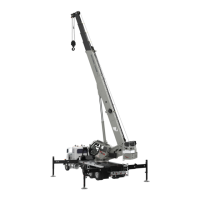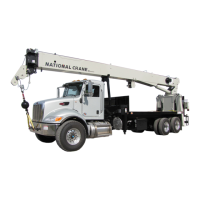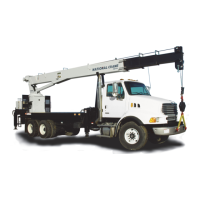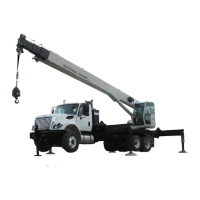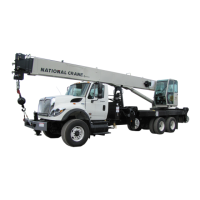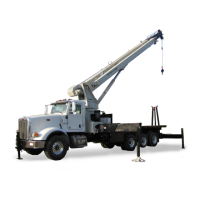NATIONAL CRANE Published 9-26-2018 Control # 646-02 2-7
NTC55 OPERATOR MANUAL SAFETY PRECAUTIONS
provided to assist in determining safe operation in windy
conditions.
Always use extreme caution when windy conditions exist.
NEVER exceed the rated capacity shown on the Load Chart.
Always check the Load Chart to ensure the load to be
lifted is within the rated capacity of the crane.
Wind can have a significant effect on loads that may be lifted
by a crane. Wind forces act differently on a crane depending
upon the direction from which the wind is blowing (e.g., wind
on the rear of the boom can result in decreased forward
stability, wind on the underside of the boom can result in
decreased backward stability, wind on the side of the boom
can result in structural damages, etc.)
Wind forces can exert extreme dynamic loads. National
Crane recommends that a lift not be made if the wind can
cause a loss of control in handling the load.
Wind forces can be determined by typical visible effects on
the landscape.To assist you in determining prevailing wind
conditions, refer to Table 2-1.
NOTE: The wind speed corresponding to the Beaufort
scale in the table is mean wind speed at 10 m
(33 ft) elevation over a period of 10 minutes.
Table 2-1 Beaufort Wind Scale
Wind Speeds
The maximum permissible wind speed referred to in the load
charts is the 3-second wind gust speed measured at the
boom tip height and is designated as V(z). This value is
either recorded at boom tip or calculated based on mean
wind speed recorded at crane operation site. For lift planning
purposes only, the 3-second wind gust speed, V(z), may be
calculated based on mean wind speed reported at http://
www.windfinder.com “Super Forecast”.
This 3-second wind gust is assumed to act on the entire
crane and the load. The wind effect on the load can be
conservatively estimated as:
a) If V(z) is ≤ 13.4 m/s (30 mph), then the allowable
load is the published rated capacity from the Load Chart.
b) If V(z) is > 13.4 m/s (30 mph) and is ≤ 20.1 m/s
(45 mph), the allowable load is the published rated
capacity multiplied by the Capacity Reduction Factor
from Table 2-4 (metric) or (non-metric).
Maximum Wind Speed
Beaufort
Number
Description m/s km/h mph
Visible Indicator
Effects of wind as observed on land
Zero (0) Calm 0.3 1.1 0.7 Calm; smoke rises vertically
1 Light Air 1.5 5.4 3.4
Smoke drift indicates wind direction. Leaves and wind vanes
are stationary.
2 Light Breeze 3.3 11.9 7.4
Wind felt on exposed skin. Leaves rustle. Wind vanes begin to
move.
3
Gentle
Breeze
5.4 19.4 12.1
Leaves and small twigs constantly moving. Light flags
extended.
4
Moderate
Breeze
7.9 28.4 17.7 Dust and loose paper raised. Small branches begin to move.
5
Fresh
Breeze
10.7 38.5 23.9
Branches of a moderate size move. Small trees in leaf begin to
sway.
6
Strong
Breeze
13.8 49.7 30.9
Large branches in motion. Whistling heard in overhead wires.
Umbrella use becomes difficult. Empty plastic bins tip over.
7 High Wind 17.1 61.6 38.3 Whole trees in motion. Effort needed to walk against the wind.
8 Gale 20.7 74.5 46.3
Some twigs broken from trees. Cars veer on road. Progress on
foot is seriously impeded.
9 Strong Gale 24.4 87.8 54.6
Some branches break off trees, and some small trees blow
over. Construction/temporary signs and barricades blow over.
10 Storm 28.4 102.2 63.5 Trees are broken off or uprooted, structural damage likely.
